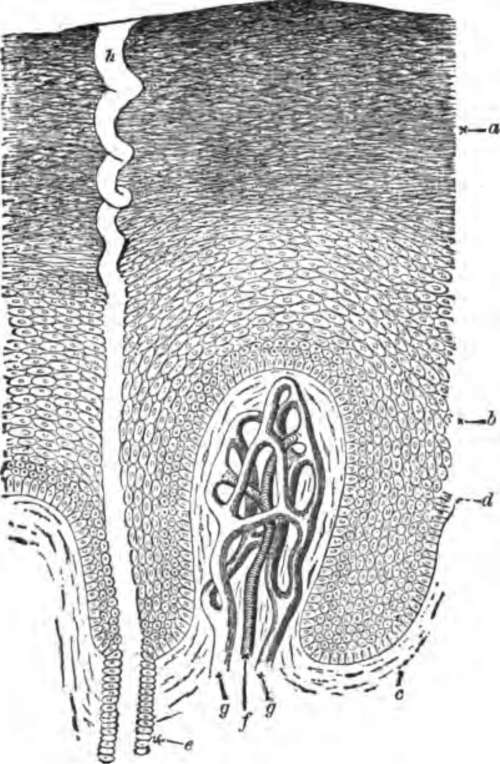The Papillae Of The Dermis
Description
This section is from the book "The Human Body: An Elementary Text-Book Of Anatomy, Physiology, And Hygiene", by H. Newell Martin. Also available from Amazon: The Human Body.
The Papillae Of The Dermis
The outer surface of the corium is almost everywhere raised into minute elevations, called papillę, on which the epidermis is moulded, so that its deep side presents pits corresponding to the projections of the dermis. In Fig. 75 is shown a papilla of the corium containing a knot of blood-vessels, supplied by the small artery, f, and having the blood carried off from them by the two little veins, gg. Other papillę contain no capillary loops, but, instead, special organs connected with nerve-fibres, and supposed to be concerned in the sense of touch. On the palm of the hand the dermic papillę are especially well developed (as they are in most parts where the sense of touch is acute), and are frequently compound or branched at the tip. On this surface of the hand they are arranged in rows ; the epidermis fills up the hollows between the papillę of the same row, but dips down between adjacent rows, and thus are produced the finer epidermic ridges seen on the palms.* The wrinkles of old persons are due to the absorption of subcutaneous fat and of other soft parts beneath the skin, which, not shrinking itself to the same extent, is thrown into folds.
Hairs, longer or shorter, are found all over the surface of the body, except in a few regions, as the palms of the hands and the soles of the feet. A hair is a slender thread of epidermis, developed on a special dermic papilla placed at the bottom of a depression, formed by a pitting-in of the dermis. The depression is known as the hair follicle. The part of the hair buried in the follicle is called its root; this is succeeded by a stem, which (in uncut hairs) tapers off to a point. Each hair is made up of a number of epidermic cells, arranged together so as to form a fibre.
How ? Where do we find plain muscular tissue in the corium ? What blood-vessels are found in it ? What else ?
What are the papillę of the epidermis ? Describe a papilla containing blood-vessels. What is found in other papillę? Name a region of the skin where the dermic papillę are especially developed. How are the ridges seen on the palm of the hand produced ? To what are the wrinkles on the skin of elderly persons due ?

* The more marked furrows of the palm, the so-called " lines of life " of the gypsy's palmistry, have a different origin.
Continue to:
- prev: The Skin
- Table of Contents
- next: Nails Fo Humans
